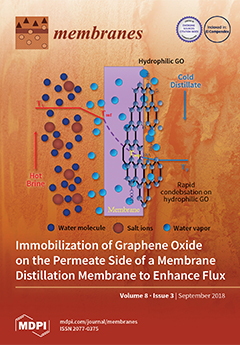Chemical grafting or crosslinking of polyimide chains are known to be feasible approaches to increase polymer gas-pair selectivity and specific gas permeance. Different co-polyimides; 6FDA-ODA and 6FDA-ODA:DABA were synthesized using a two-step condensation method. Six different cross-linkers were used: (i)
m-xylylene diamine; (ii)
n-ethylamine; and (iii)
n-butylamine, by reacting with 6FDA-ODA’s imide groups in a solid state crosslinking; while (iv) ethylene glycol monosalicylate (EGmSal); (v) ethylene glycol anhydrous (EGAn); and (vi) thermally labile iron (III) acetylacetonate (FeAc), by reacting with DABA carboxyl groups in 6FDA-ODA:DABA. The gas separation performances were evaluated by feeding an equimolar CO
2 and CH
4 binary mixture, at a constant feed pressure of 5 bar, at 25 °C. Fractional free volume (FFV) was calculated using Bondi’s contribution method by considering the membrane solid density property, measured by pycnometer. Other characterization techniques: thermal gravimetric analysis (TGA), differential scanning calorimetry (DSC), scanning electron microscopy (SEM), Fourier transform infrared spectroscopy (FTIR) were performed accordingly. Depending on the type of amine, the CO
2/CH
4 selectivity of 6FDA-ODA increased between 25 to 100% at the expense of CO
2 permeance. We observed the similar trend for 6FDA-ODA:DABA EGmSal-crosslinked with 143% selectivity enhancement. FeAc-crosslinked membranes showed an increment in both selectivity and CO
2 permeability by 126% and 29% respectively. Interestingly, FeAc acted as both cross-linker which reduces chain mobility; consequently improving the selectivity and as micro-pore former; thus increases the gas permeability. The separation stability was further evaluated using 25–75% CO
2 in the feed with CH
4 as the remaining, between 2 and 8 bar at 25 °C. We also observed no CO
2-induced plasticization to the measured pressure with high CO
2 content (max. 75%).
Full article






